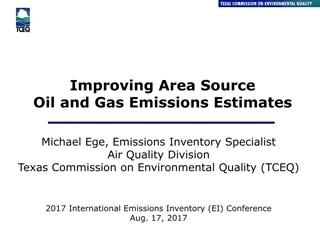Public Participation in Industrial Emissions Directive: Case Study on Ammonia Production
The case study focuses on public participation aspects in the context of the Industrial Emissions Directive for an ammonia production facility located near borders of multiple countries. It includes details on the installation's location, potential impacts, and challenges related to notification of stakeholders, such as local communities, landowners, NGOs, and residents within a certain radius. The various legal challenges and claims from different entities add complexity to the regulatory process.
- Public participation
- Industrial Emissions Directive
- Case study
- Ammonia production
- Regulatory challenges
Uploaded on Oct 05, 2024 | 0 Views
Download Presentation

Please find below an Image/Link to download the presentation.
The content on the website is provided AS IS for your information and personal use only. It may not be sold, licensed, or shared on other websites without obtaining consent from the author. Download presentation by click this link. If you encounter any issues during the download, it is possible that the publisher has removed the file from their server.
E N D
Presentation Transcript
Jerzy Jendroka Public participation in the framework of Industrial Emissions Directive: Case study
Installation and its location Installation for production of ammonia, in country A 3 km from the border with country B and 4,5 km from the border with country C Integrated permit:to be issued by environmental authority at the district (country) level in country A All three countries have different languages (neither is English)
Potential impact Operator claims that technology to be applied assures no impact outside the premises Routine possible impact (air pollution) according to official guidelines 5 km Potential impact as a result of accident according to some research 10 km
Vicinity within 5 km diameter Inside the country A 3 willages (about 400 persons) 40 owners of land In neighbouring country B 2 villages with 200 persons 20 owners of land In neighbouring country C 3 owners of land
Vicinity within 10 km diameter Inside the country A 6 willages (about 700 persons) 80 owners of land In neighbouring country B in one local community 4 villages (about 400 persons) and 20 owners of land In another local community 1 residential house with 8 families renting apartments 3 owners of land In neighbouring country C 4 villages (about 400 persons) and 20 owners of land
Legal challenge regarding notification NGO located in Brussels claims that it should have been notified individually in English because it has a project regarding ammonia industry and their already were seeking information on this installation NGO located in the capital of country B claims it should have been notified beacuse they hold (long-term lease) a land within 5 km diamater owner of a land in country A located 40 km from the installation (in another distric) claims that he should be notified beacuse lorries with ammonia from the installation tend to stop tin his village and cause a lot of pollution there and therefore he and his neighbours have an interest in the operation of the installation owner of he land within 5 km diamater be notified NGO of country A claims that all persons within the 10 km diameter in all countries should be notified in country C claims that he should
The authority maintains -although the operator claims no impact outside installation and there is no reason to expect significant negative effects on the environment in another country nevertheless the authority followied art.26 of IED and notified via competent national authorities the competent national authorities in countries B and C but they confirmed lack of significant negative effects on their teritory . Thus there is no legal obligation to notify the public concerned abroad. the public in its own country was notified, in accordance with IED and national law, by putting a notice in the local press in the district and by putting a notice on the webpage of the authority, which however at some point was not in operation due to technical problems
Questions Looking from the point of view of: Your own national law IED Aarhus Convention Please examine the above desrribed situation with a view to identify who should be considered as the public concerned how the public concerned should be notified who would have aceess to justice and what could be subject to challenge























